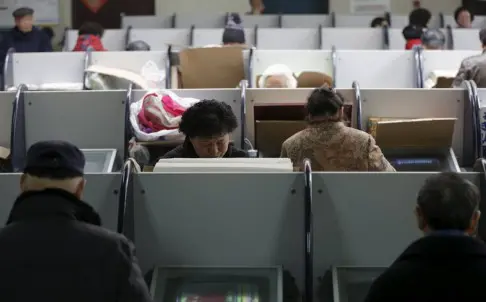(SOUTH CHINA MORNING POST)The wide gap between the A shares in Shanghai and H shares in Hong Kong shows the one-year-old stock connect scheme has not offered arbitrage opportunities for the two markets due to regulatory differences.
The Hang Seng China AH Premium Index, which tracks the difference in share prices of companies listed in both Hong Kong and on the mainland, closed at 141.93 on Tuesday. This means A shares listed in Shanghai and Shenzhen are, on average, trading at a premium of 41.93 per cent compared with their H share counterparts in Hong Kong. The record high since the index was launched in 2008 occurred in September last year, when it hit 149.
Before the stock connect scheme was launched in November 2014, the index on one occasion dropped to 100, meaning that, on average, the A and H shares were trading at similar prices. That was because many market players believed cross-border trading, allowing mainland investors to trade Hong Kong stocks via the Shanghai Stock Exchange and letting international investors trade Shanghai-listed A shares, would open up arbitrage opportunities and narrow the price gap. However, since the launch of the scheme the index has kept rising.
Louyang Glass has the widest gap, with its H shares closing at HK$4.08 on Tuesday, while its A shares closed at 24.07 yuan (HK$28.55) in Shanghai. Sinopec Oil Services H shares closed at HK$1.82 while its Shanghai-listed A shares closed at 6.35 yuan.
“The spread between A and H shares has widened in large part due to the vastly different underlying investor base, coupled with the pressure on H shares driven via the dollar peg,” said Brett McGonegal, co-chief executive of Reorient Group.
He said the A-share market was predominantly driven by retail investors while the H-share market had a much bigger institutional base.
“As the recent market turmoil has played out, the institutions have taken more of a sell now and take a look later [approach]. The retail investors have been more daring in sticking with the A-share names and more importantly shifting in a flight to quality out of more speculative names into larger-cap names that also have H-share listings,” McGonegal said.
“This action has resulted in a widening gap as H shares are being sold and compressing prices while their A-share counterparts are most often the beneficiary of stock rotation into large-cap, less-volatile names.”
He said the currency issue also had an impact. Under the peg, Hong Kong has to follow the US in increasing interest rates, which also leads to selling pressure for H shares. The US increased its benchmark rate for the first time in 10 years last month.
Keith Pogson, senior partner for Asia-Pacific financial services at accounting firm EY, said that while the stock connect scheme might have provided opportunities for investors on both sides of the border to arbitrage the difference, this would only work well if investors could take one stock in one market and deliver it to another, such as is the case with American Depository Receipts (ADRs).
“You can arbitrage the difference by buying one and shorting the other and hoping that by weight of common sense and economic fundamentals the two markets will converge and hence realise a premium, but there exist a number of factors that stop this,” Pogson said.
One difficulty is execution costs, such as borrowing costs for the stock to conduct the short selling. Another challenge is regulatory differences, with China liable to stop short selling on occasion, whereas Hong Kong allows it. Mainland stocks might sometimes be suspended from trading after rising or falling by the 10 per cent the price limit for the day, but their H shares in Hong Kong would continue trading, he said.
“The mainland market does not really trade on fundamentals such as dividend yields and modelled growth but on what is politely called momentum trading,” Pogson said. “The international market, which is characterised by Hong Kong, is driven by those fundamentals as well as a global macro view.”
Henry Chan, chief investment officer at BEA Union Investment Management, said the recent central government intervention in the A-share market had created more divergence between A and H shares because the major shareholder shares sale ban had led to stock supply being constrained by lock ups.
Beijing banned major shareholders and senior executives from selling shares for six months in June. It has now imposed a lot of restrictions on such sales, whereas there are no such hurdles in Hong Kong.
“The Hong Kong market is more governed by international institutional investors who are more sensitive on valuations and currently expressing a more bearish view on China,” Chan said. “This has created further divergence.
“Technically the two share classes are not fungible after all. Despite the expansion of the premium of A over H shares, the correlation of share price direction between the two share classes has been increasing and this could be partly attributable to the increasing awareness of investors of the movements in both markets.”
 简体中文
简体中文

